Page 2 -- Features and Benefits
Features and Benefits
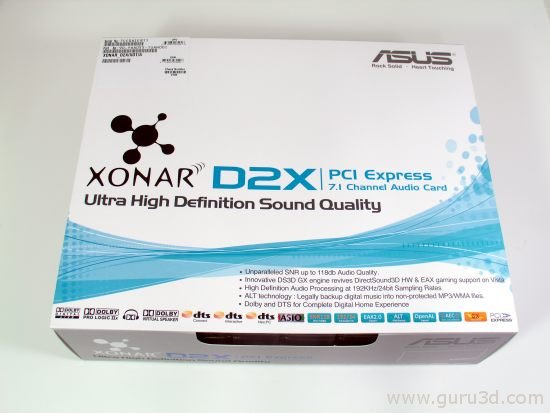
The D2X is a high-end, take-no-prisoners sound card, with very little left to be desired. There arent many features that we havent seen before in current sound cardslike Auzentechs X-Meridianbut Asus does show a little innovation here and there. The most noticeable feature is the quasi-functional, but mostly cosmetic, EMI shield. I say quasi-functional, because most noise will be coming in from the PCIe power pins. Asus doesn't stop there with the EMI shield, it also took precautions in the circuit designs too. We'll see more of that later on.
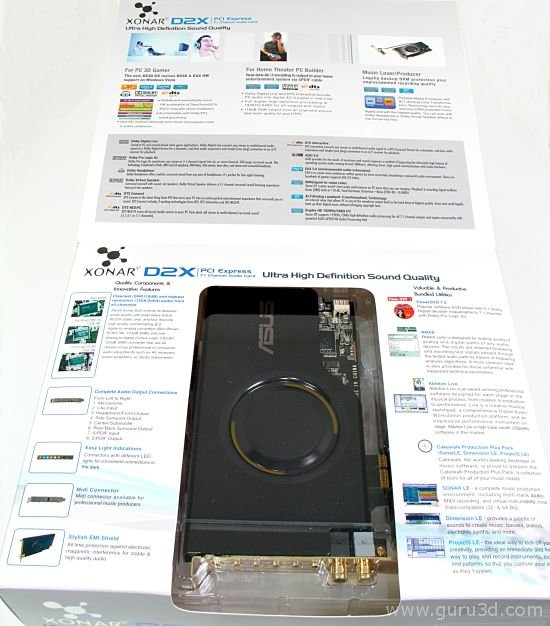
Lets take a look at the specifications, though with a list this long it will take a few pages. Ill list just the basics and cut out the fat. Here we go:
- 8-channel (7.1 surround) output at 24 bit/192 KHz maximum
- Texas Instruments/Burr-Brown PCM1796 DACs to those 7.1 channels
- 2-channel input at 24 bit/192 KHz maximum, via Cirrus Logic CS5381 ADC
- 1x PCI-Express interface (PLX 8111 PCI to PCIe bridge chip)
- Asus AV200 APU (a re-branded C-Media Oxygen HD CMI8788 of some sort)
- S/PDIF input and output, both with optical and coaxial connections
- MIDI input and output via daughtercard
- Real-time DTS and Dolby Digital Live encoding
- Dolby Pro Logic IIx, Headphone, and Virtual Speaker
- DTS Connect (DTS Interactive and DTS NEO:PC, all wrapped in one)
- EAX 2.0, OpenAL, and the new, new hotness DS3D GX
- LEDs and Gold Bling
- Stylish EMI shield
One thing that we always like to see is a good bundle of stuff to increase the bang-for-the-buckness. Creative has traditionally been the kings of bundle (and some of it was even useful), and Asus seems to have followed their lead. Theres quite a bit of software, which Ill discuss a bit later, and quite a bit more cable and even an extension card for the MIDI cables. Like I said, the D2X is no-holds-barred.
Another point of interest about the bundle is the inclusion of 4 3.5mm-to-phono cables, which means Asus is confident about its product. It's also a veritable sea-monster of cables. These you would plug into your receiver or powered speakers, of course. I find it odd to include these since most folks would opt to use the optical cable to transfer raw data and let the receiver do the decoding. It's also the main reason you'd want to be doing DDL and DTS encoding, too.
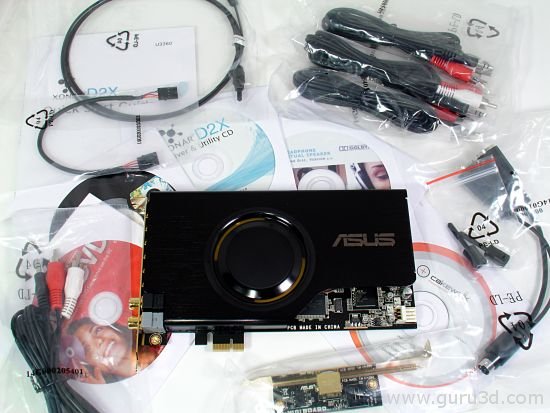
Well, considering the quality of the analog output of the D2X, you would need a very expensive receiver to match the D2X.
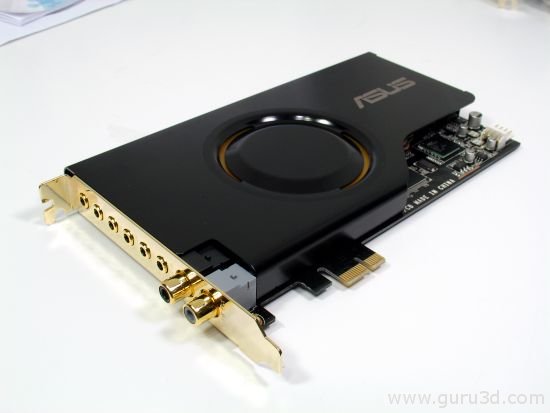
The D2X does the usual 7.1 surround sound, which has been standard on sound cards since beyond memory, and it also does two channel analog-to-digital. The trick to this pony is that the D2X will do all of these inputs and outputs at the highest available quality, 24 bit/192 KHz. As and aside, theres a feature ASUS calls ALT, Analog Loopback Transformation, which takes advantage of all this resolution. I think its a bad idea, really, giving ammunition to the DRM camp by giving the analog hole a name. I mean, the analog hole is the analog hole! But, basically, yeah, you can record what gets played with as little loss in fidelity as possible. Brilliant.
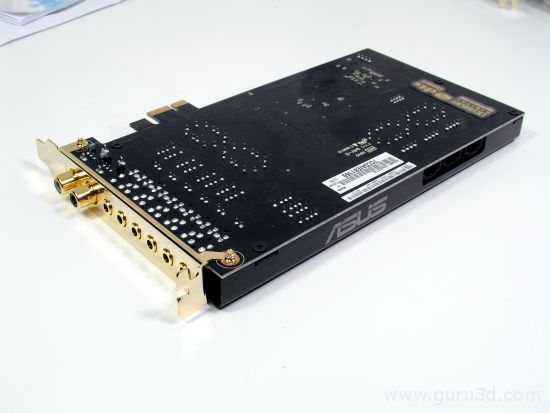
PCI-Express is showing up in more sound cards, but just a handful by last count. A lot of enthusiasts are sighing relief because now theres finally something to plug into that spare PCIe 1x slot. While Creative mentioned in a press release that their PCIe implementation had too much latency, which delayed the release of the X-Fi PCIe Xtreme Audio and X-Fi Titanium series of cards that are native PCIe, the Asus D2X and DX are not native and rely on a bridge chip from PLX, to translate from PCI to PCIe. It may seem inelegant to use a bridge chip, but I havent seen any reports of excessive latency with the D2X, and their products were released in a timely manner.
At the heart of the machine is the AV200 APU, which Im told is not quite a C-Media CMI8788 chip. The sales rep I spoke to mentioned it was a CMI8790, but of course C-Media has no information on this chip, but its interesting that sound cards using the old CMI8788 are hard to find.
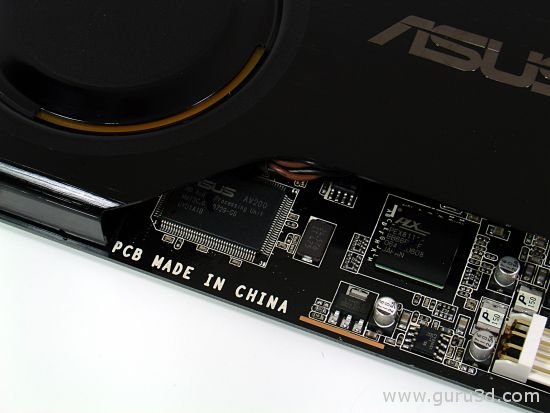
Creative likes to quote the DACs fidelity (the SNR, for example), but it doesnt tell the whole story. The op-amps do have a significant role in taking the output of the DAC and turning it into sound that your speakers can use, though. Auzentech showed quite a bit of innovation with their replaceable op-amps in their X-Plosion and X-Meridian sound cards to very good success. Asus chose the non-replaceable route (and not a bad idea considering the some-disassembly-required nature of the D2X), and soldered the op-amps directly onto the board.
The Digital to Analog converters in the D2X are of the highest quality from Texas Intruments Burr-Brown. DACs are often used in PR literature to give the buyer an impression of the overall quality of the piece of equipment youre looking at. While quoting DAC numbers do tend to give you an idea of sound quality, it is a fallacy to trust them. Sound has to pass through a lot of circuits before it reaches your ears.
Let's start from a 16 bit/44.1 KHz WAV file, say, heres a short audio story for you. When you hit play, the data in the file is sent to the device (we assume drivers, OS, and hardware is working properly, of course). Inside the audio processor the data stream is routed to the proper place (volume, does it need SRC, effects, or filters applied), and then sent to the DAC for reconstruction into analog. Bits are basically bits until it hits the DAC. Once through the DAC the analog waveform is sent to the op-amps, where depending on volume and load (headphones, speakers, etc.), the sound hits the air for your ears to hear. It is nice to have fancy DACs and LED bling, nothing effects sound more than source and speakers. Well, your mood might have a lot to do with it too, but lets keep it simple and say, the stuff in the middle should have as little an impact on the audio as possible.
Now that Ive scared off the riff-raff with the uber-long specification section, lets get down to business.
